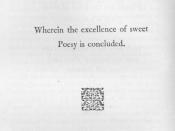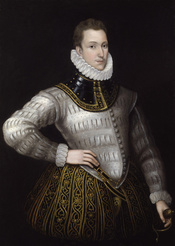Sir Philip SidneyÃÂs Sonnet 7 is from the sonnet sequence Astophel and Stella dating from the sixteenth century. It is a lament by one of the central figures, Astophel, a man who is in love with the other central figure, Stella, who is ultimately unattainable because she is married to another man.
In the first few lines of the poem, Astrophil talks about StellaÃÂs black eyes and how they ÃÂbeam so brightÃÂ (ll. 2) and how in ÃÂbeamy blackÃÂ (ll. 3) she radiates beauty. The excerpt chosen begins with ÃÂOr did she else that sober hue devise,/ In object best to knit and strength our sight,ÃÂ (ll. 5-6) meaning that perhaps her eyes are not only black but she is actually wearing black, and uses this color as an object to help make her more noticeable among other ÃÂshades and lightÃÂ (ll. 4). The image given here is one of black versus white ÃÂ specifically, ÃÂbeamy blackÃÂ (ll.
3) versus ÃÂluster shades and lightÃÂ (ll. 4). However, as one would more traditionally see the sparkling shades and light as way of ÃÂstrength[ening] our sightÃÂ (ll. 6), in this case it is in fact black, that makes her stand out and more noticeable, because she makes it more beautiful than anything else in comparison. In the next two lines Astrophil says, ÃÂLest if no veil these brave gleams did disguise,/ They, sun-like, should more dazzle than delight?ÃÂ (ll. 7-8) meaning that if nothing was to cover her black ÃÂsun-likeÃÂ (ll. 8) eyes it would only further intensify ones confusion rather than just being a source of enjoyment for the onlooker. In the next two lines Astrophil again reiterates how with her ÃÂmiraculous powerÃÂ (ll. 9) she makes black ÃÂÃÂbeautyÃÂs contraryÃÂ (ll. 10) ÃÂ a source for all ÃÂbeauties [to] flowÃÂ (ll.


